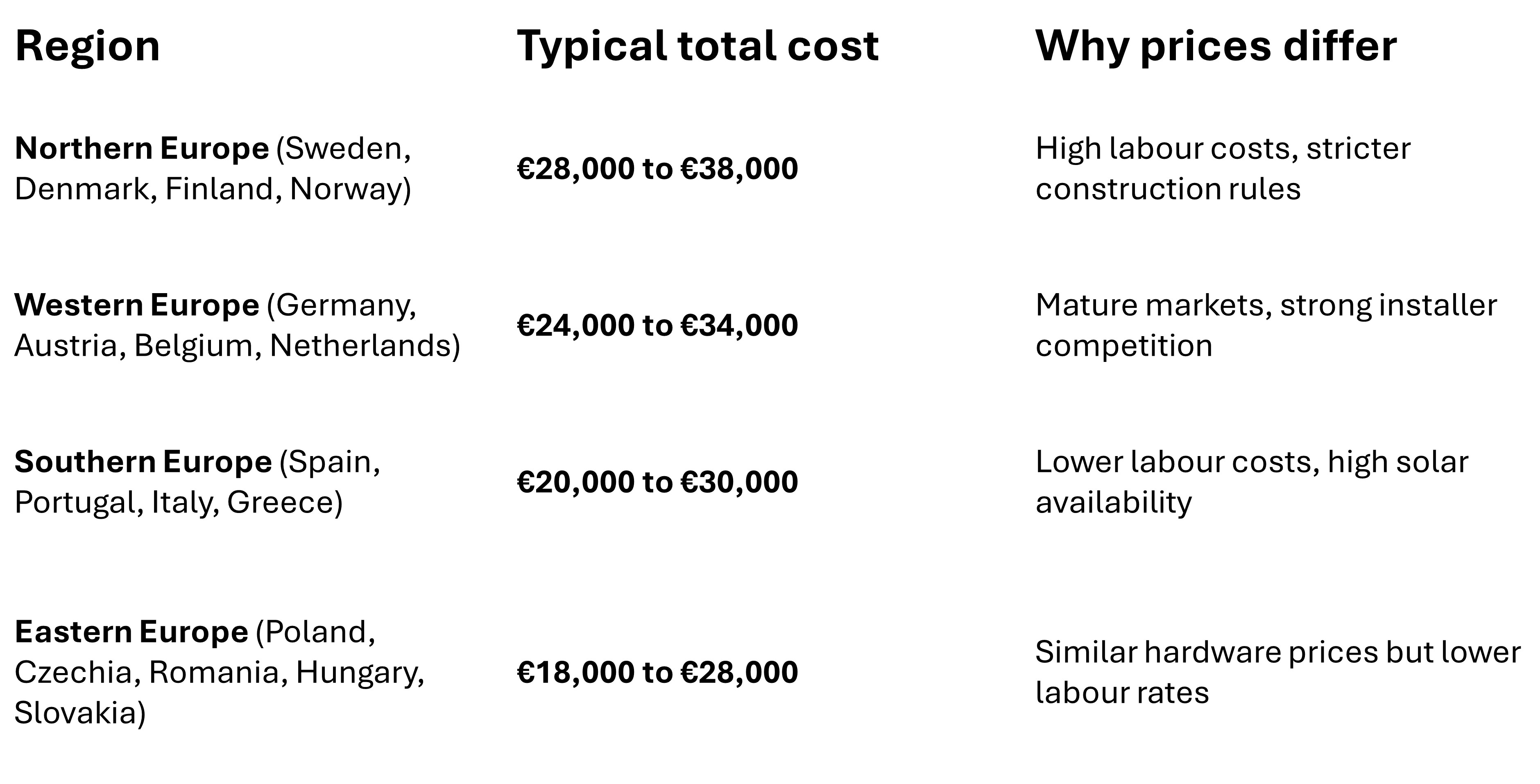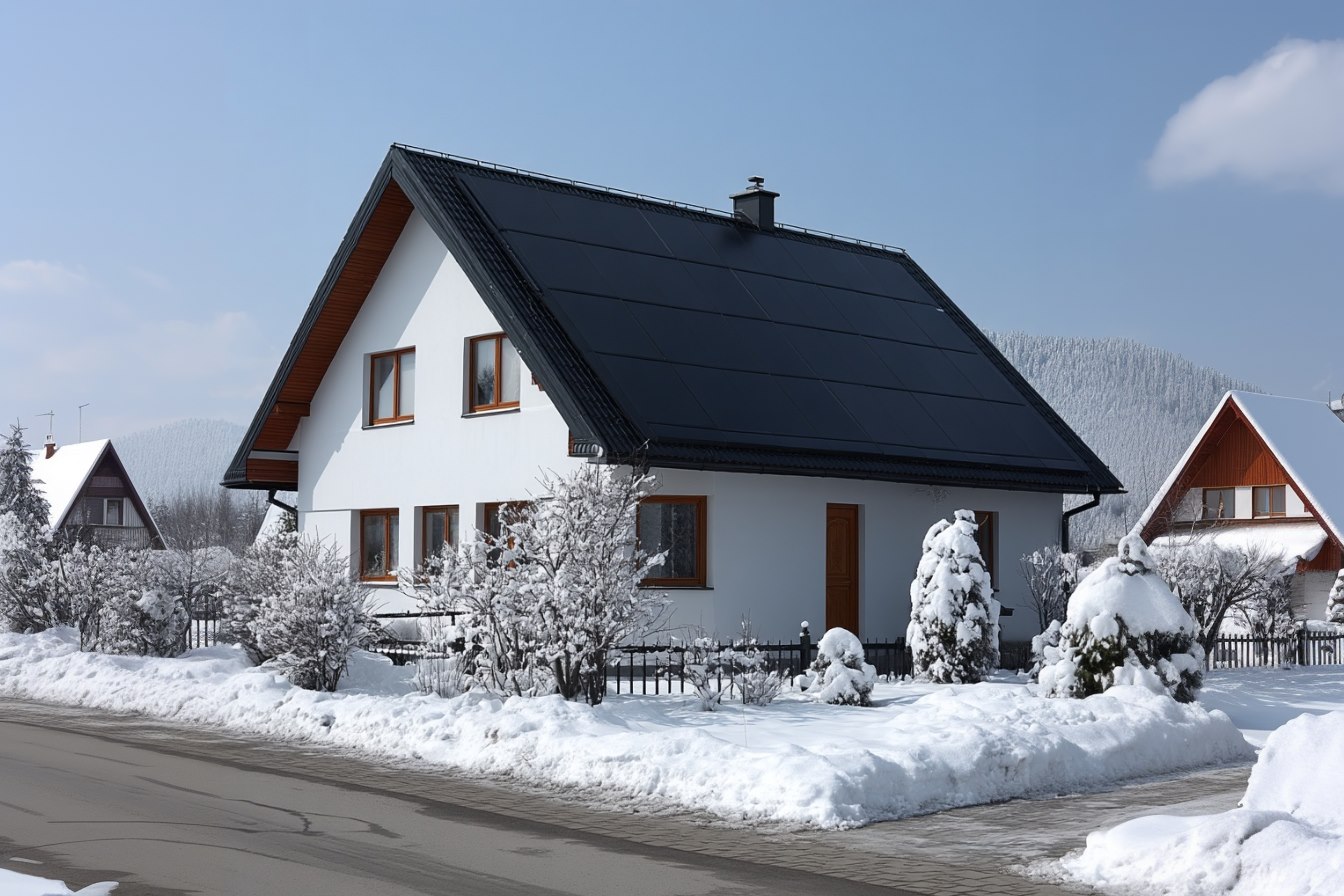How much does a 20 kWp solar system with storage cost in Europe?
A 20 kWp photovoltaic system is a popular choice for larger single-family homes, appartment buildings and small commercial properties. It produces enough electricity to cover high household demand and can support heat pumps, electric vehicles and smart home technologies. Many homeowners wonder what they can realistically expect to pay in Europe for panels, storage and installation. Prices vary across regions, but there are clear patterns that help you estimate your total investment.
What influences the price of a 20 kWp system
The solar modules you choose
The choice of module technology makes a noticeable difference. High performance modules like the EcoLife Series with modern so-called back contact technology (BC) reach efficiencies up to 25% percent and deliver more power per square metre. EcoLife ranges from 480 to 510 Watt – which is compact for its size of 1,8m × 1,13m.
The smaller and more compact a system, the better limited roof space or complex layouts can be used. Conventional modules with lower efficiency require more panels to reach 20 kWp. That increases the number of mounting points and installation time. For example, with an EcoLife 510 W back contact module, a 20 kWp system needs around 40 panels. A typical 430 W standard module needs about 47 panels for the same 20 kWp. Those extra seven modules mean more mounting rails, more roof penetrations and more installation work, and they also increase the required roof area by roughly 15 to 20 percent.
The size and structure of your roof
A large, unobstructed roof lowers costs. A smaller or segmented roof with chimneys, skylights or dormers increases mounting material, labour time and planning. Efficient modules reduce the number of panels required, which is helpful on roofs that have limited usable area.
The battery size
Most homeowners pair 20 kWp with battery storage between 10 and 20 kWh. Larger storage capacities increase independence and self consumption, yet they also raise the total system cost.
Installer pricing and the regional market
Installers in Europe usually sell package prices. They combine panels, inverters, battery storage, mounting materials, cables and labour into one total sum. This makes price breakdowns difficult, since individual components are rarely visible.
How many panels do you need for 20 kWp?
The exact number depends on the technology deployed, the module efficiency and power output.
- High efficiency back contact modules in the EcoLife range (480 to 510 W): About 40 to 42 panels for 20 kWp.
- Conventional modules with other technologies (around 430 to 440 W): About 46 to 47 panels for 20 kWp.
The difference can decide whether a system fits onto a roof without sacrificing orientation or performance. High efficiency modules reduce the footprint and keep the layout simple.
How storage prices developed in Europe
In Europe residential battery-storage system prices declined sharply from early 2023 into 2025, with average end-user pricing around €700 per kWh in the second half of 2025 (with a typical range from about €400 up to more than €1,200 per kWh depending on size, chemistry, brand and country). The reasons include falling cell-material costs, stronger competition and scaled manufacturing. While the steep cost drop has largely occurred, the end-user market still shows a broad spread and further declines are expected to be more modest.
For a typical 10 to 20 kWh home battery in Europe, homeowners can expect storage costs between roughly €7,000 and €14,000 on average, though prices range greatly from country to country. Premium systems can exceed €18,000.
What about installation costs
Installation costs depend on labour rates, roof complexity and system size. A 20 kWp installation requires more time than a smaller residential system. Installers in Northern and Western Europe generally have higher labour costs than installers in Eastern or Southern Europe. Complexity, cable routing and roof material can also change the final price. For a 20 kWp rooftop system, installation often represents around 20 to 30 percent of the total package price.
Which part of the system costs the most
In a typical 20 kWp rooftop system with storage the cost split might look like this: about 35-45 % for solar modules plus inverter, 30-40 % for battery storage, and 20-30 % for installation labour and mounting. The exact shares depend on battery size, module efficiency, roof complexity and local labour cost. In systems where the battery size is large relative to the PV array, the battery cost may equal or even exceed the panel cost.
Regional price differences in Europe
Prices vary significantly across Europe due to labour rates, installer market maturity and national subsidies. Here is an overview:

Why investing in high performance modules pays off
High performance back contact technology delivers higher energy yield throughout the day, including in low light, and keeps output stable for decades because the back contact cell design reduces stress points and microcracks. Modules like the EcoLife Series from LONGi show strong resilience in demanding climate conditions, including hail, storms and heavy snow. They are tested to withstand snow loads up to 6,000 Pa, roughly four metres of snow or the weight of an adult standing on each panel, and wind pressures up to 3,600 Pa, similar to coastal storm gusts.
Back contact products reach high fire safety classes and frequently offer improved shading behaviour, so even partial shade has less effect on output. Finally, they have a beautiful, uniform black surface giving them a clean aesthetic. Together with the long-term reliability strengthening the system’s financial return, they offer both visual quality and dependable performance for homeowners.
Additional points homeowners frequently ask about
Permits and grid connection differ by country and sometimes by region and can add small fees or delays. Some countries require a simple online notification, others need structural checks, electrical approvals or local authority registrations. Grid operators may request technical documents, single-line diagrams or meter upgrades. These steps can add small administrative fees and, in some cases, waiting times before the system can be fully activated.
Warranty conditions vary widely. Long warranties for modules, inverters and storage increase system value. They matter for installers because they carry responsibility for the long term performance of the systems they build. Installers pass on the manufacturer warranties for modules, inverters and storage to the homeowner and usually add their own workmanship warranty for the installation. Strong and clearly defined warranties reduce risk for both sides and increase long term system value.
Smart home integration improves energy usage and can increase financial returns, because connected devices coordinate how and when electricity is used. A PV system can automatically run appliances when solar production is high, charge the battery at the right moments, prioritise essential loads and avoid drawing power from the grid during expensive tariff periods. Heat pumps, EV chargers and smart meters can work together so more of the solar electricity stays in the home. This reduces energy bills, increases self consumption and makes daily energy use more efficient without manual effort.
Heat pump compatibility is a common motivation to size a system at 20 kWp because modern heat pumps consume a significant share of a home’s annual electricity, especially in winter. A larger PV system provides enough daytime production to cover heating and hot water needs and keeps the battery charged for evening use. Homes with underfloor heating, larger living areas or high hot water demand benefit from the additional PV capacity. A correctly sized system stabilises running costs, reduces reliance on grid electricity and helps the heat pump operate at its most efficient settings throughout the year.
Subsidies or tax incentives differ between countries and can reduce total cost significantly. Many governments offer upfront grants for PV and storage, reduced VAT rates, tax deductions, low interest loans or feed-in premiums for exported electricity. Some regions provide extra support for heat pump integration or energy-efficient renovations when combined with solar. Incentive levels can change annually and often depend on system size, component quality and whether the home is owner-occupied. These programmes can lower the investment by several thousand euros and shorten the payback period, which is why checking national and local incentives is an important part of the planning process.
Start your solar journey with the right module
If you intend to start your solar journey and have decided to choose among the top tier solar modules on the global market, EcoLife is a strong foundation for long term performance and value. The high efficiency and compact footprint make it easier to reach 20 kWp even on challenging roofs, while the robust mechanical strength, reliable low light behaviour and strong safety ratings ensure stable output in all seasons. The uniform black design blends seamlessly into modern homes, and the long warranties of 30 years give both homeowners and installers confidence for decades. With EcoLife, a 20 kWp system with storage becomes a durable, future proof investment.
More blog Articles



.jpg)
